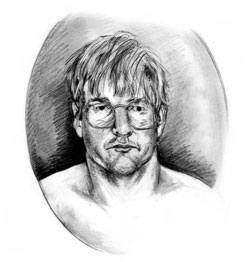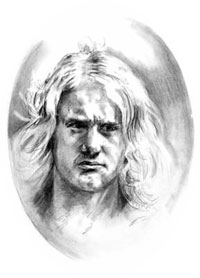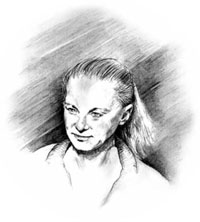Crime Time: Australians Behaving Badly (13 page)
Read Crime Time: Australians Behaving Badly Online
Authors: Sue Bursztynski
Tags: #Children's Books, #Education & Reference, #Law & Crime, #Geography & Cultures, #Explore the World, #Australia & Oceania, #Children's eBooks
PETER DUPAS
SERIAL KILLER
P
eter Dupas committed his first violent crime in 1968, when he was only fifteen. He asked a neighbour to lend him a knife for peeling vegetables and then stabbed her with it. She survived the attack and Peter told police he didn’t know why he’d done it.
That time, he only got probation and psychiatric treatment.
Over the next few years, Dupas spent time in jail for several more attacks on women.
Every time Dupas came out of jail for one offence, he would commit another. Despite this, he often didn’t serve full terms for his crimes.
The first murder for which Dupas was jailed was the last he actually committed. Evidence for two others turned up after he was already behind bars.
Nicole Patterson was a youth counsellor. She had a job working for the Ardoch Youth Foundation, but she wanted to do some private work from her home in the Melbourne suburb of Northcote. In 1999, she advertised in the local newspapers and had a call from someone who told her his name was Malcolm. She made an appointment and wrote it into her diary, along with a mobile phone number.
On the morning of 19 April, neighbours heard screams coming from her house. Later that day, a friend coming to take her to dinner found her mutilated body. She had been stabbed 27 times. Her breasts had been cut off. They were missing. So was the murder weapon.
Police checked the mobile phone number in Nicole’s diary. The phone belonged to someone else, who let them know Peter Dupas’ name.
Dupas had been planning the murder carefully. He’d phoned Nicole three times, supposedly to arrange counselling, but really to find out how easy it would be to kill her. Police found plenty of evidence at his home. There was bloodstained clothing, tape similar to tape found on the victim’s body, a balaclava, her ad from the local paper and clippings about the murder.
The jury took less than three hours to find him guilty. He was sentenced to life imprisonment.
While he was in jail, evidence turned up for other murders which had been unsolved until then.
A woman called Margaret Maher had been murdered in October 1997, in the suburb of Broadmeadows. A man found her body under a cardboard box. Her breasts, like Nicole’s, had been cut off. There was a black glove found near the body which turned out to have Dupas’ DNA on it.
The trial for this murder, in 2004, went for three weeks. Again, Dupas was found guilty and sentenced to life imprisonment. The jury didn’t know he was already in prison for another murder.

Only a month after the murder of Margaret Maher, Mersina Halvagis went to visit her grandmother’s grave at Melbourne’s Fawkner Cemetery. Her fiancé found her body. She had been stabbed 87 times, mostly around the breasts.
Dupas, who was already in prison for the other crimes, was not convicted right away, even though many witnesses said they had seen him at the cemetery that day. His defence lawyer argued that he was suspected just because he lived nearby and he’d been in trouble for violent crimes before. That didn’t mean he’d done it this time.
But there was a breakthrough late in 2006. A man called Andrew Fraser had known him in the Port Phillip Prison in 2002. He said that while they were gardening one day, they had found a homemade knife. Dupas had held it, murmuring, ‘Mersina, Mersina…’ When another prisoner had accused him of murdering her, he’d asked Andrew Fraser, ‘How did he know I did it?’ And he had spoken of it over several months.
At the trial in 2007, it took the jury just over a day to find him guilty again. A third life sentence was added to the other two.
Peter Dupas is suspected of three more murders. Whether or not he is convicted of those, he will not be leaving prison alive.

MARTIN BRYANT
PORT ARTHUR MASSACRE
I
t was 28 April, a beautiful autumn afternoon in 1996. In the former penal colony of Port Arthur, Tasmania, tourists were enjoying the sunshine. The Broad Arrow Cafe was full of people having lunch and browsing in the gift shop. Nobody could have guessed that in a short time, 35 people would be dead and 37 others injured.
A young blond man entered the cafe, carrying a sports bag. After eating lunch, he put the bag onto a table. He took out a video camera, then pulled out a semi-automatic rifle and began to shoot people, beginning with a Malaysian couple, Ng Moh Yee William and Chung Soo Leng. Within fifteen seconds, he had shot twelve people. He didn’t know these people or care. He just wanted to shoot someone. Plenty of someones.
In eight minutes, he had murdered twenty people in the cafe and gift shop before moving on to the car park.
Outside, the man, whose name was Martin Bryant, shot some more people, including some tourists in – and under – a bus. A woman called Nanette Mikac had come to Port Arthur for a picnic with her two daughters while her husband was playing golf. Now Bryant shot her and her younger daughter, Madeline. Alannah, the elder daughter, ran away, but Martin Bryant chased her down and shot her, too. He continued his shooting spree from his car, then shot the owners of another car before stealing it. Finally, he held up a white Toyota, shot the female driver and forced the man into the boot of the car, driving the car on to a guesthouse called the Seascape. There, he dragged his hostage inside, where the bodies of the owners, David and Sally Martin, lay. He had killed them on his way to Port Arthur.
By this time, someone had contacted the police, but because Bryant had a hostage, they didn’t dare rush the house. They called in expert negotiators, who spoke to him for several hours until his phone batteries ran out. The next morning, he started a fire and ran out, his clothes burning. He surrendered to the police, who took him to hospital to have his burns treated. The police found the dead bodies of his hostage and the Martins.
Who was Martin Bryant and why did he do this terrible thing?
Martin was born in 1967. He was a strange boy who didn’t get on with anyone at school. He preferred to be alone, and was often bullied when he wasn’t terrifying people. He had a very low IQ, about 66, and didn’t seem unhappy when his father’s body was found drowned in a dam. The death was treated as suicide.
Martin’s low intelligence meant that he was able to claim a pension when he left school instead of looking for work. However, he did odd jobs for a rich woman called Helen Harvey, who lived in a huge house in Hobart. They became great friends. Helen spent thousands of dollars on Martin. When she was killed in a car crash, she left Martin all her money and the big house. He enjoyed himself, travelling and spending money, but it seems this wasn’t enough for him.

After the massacre, some people suggested that he couldn’t possibly have known what he was doing, but it turned out that he had visited Port Arthur several times before the day of the murders. He had also measured the sports bag carefully when buying it. These clear plans suggest that he did know what he was doing.
We will never be really sure of his reasons behind what he did. He was considered fit to stand trial and in November 1996 he was sentenced to 35 life sentences, one for each person he had killed, to make sure he would never be released. For ten years, Martin lived at Hobart’s Risdon Prison. In 2006, after a number of suicide attempts, he was moved to a special mental health unit, to be treated by doctors and nurses.
This tragedy led to a change in Australia’s gun laws and a ban on all semi-automatic weapons.

DID YOU KNOW…?
Con artist Murray Beresford Roberts once managed to steal some diamonds from a jewel dealer in India. Travelling to India, he posed as a rich British lord who was there at the time. Pretending he was shopping for a diamond coronet as an anniversary gift, he was introduced to a dealer, who trusted him with the coronet. Ripping the jewels out of the headpiece, he swallowed them and flew to London, where they – ugh! – came out at the other end and he cleaned and sold them. What happened when the real lord was presented with Murray’s hotel and jewellery bill, we’ll never know.
LUCY DUDKO
L
ucy Dudko was in love. The Russian-born librarian had a new boyfriend, John Killick. John was a perfect gentleman who treated her well and brought her coffee in bed every morning. Even better, she thought, he was protecting her from her violent former husband. The pair had been living together for about a year in a place called Queanbeyan in New South Wales.
There was only one problem: John was a thief. He was a thief who had been caught committing armed robbery in 1998. When he was arrested and sentenced to several years in Sydney’s Silverwater Prison, Lucy was horrified.
She decided that she wasn’t going to take this disaster lying down. She didn’t care what John had done. She loved him! She decided that she would free him, somehow.

Being a librarian, Lucy knew how to do research. She made her plans carefully and borrowed some videos to help her carry them out. There were three videos about daring prison escapes –
The Getaway, Captive
and a Charles Bronson movie,
Breakout,
in which there was an exciting escape by helicopter.
This seemed like a wonderful idea. In March 1999, Lucy spent $360 on hiring a helicopter for a joyride over Sydney. She told pilot Tim Joyce that she wanted to take a look at the site of the Olympic Games, which were going to happen the following year.
Poor Tim! How could he have imagined, when he left for work that morning, that he would suddenly find a gun being pointed at him by an excitable Russian woman, demanding that he take her to the yard of the maximum security Silverwater Prison? Being hijacked was bad enough, but when the helicopter arrived at the jail, Tim found himself being shot at!
The couple made him take them to a park near Macquarie University, where they argued as to whether or not they should keep him as a hostage. In the end, they tied him to a tree and escaped together.
For the next 45 days, the newspapers were full of their adventures. The hunt for them was on. To the annoyance of the police, many people actually hoped that Lucy and John would escape. However, their luck finally ran out in early May when they were found in a caravan park, registered as Mr and Mrs Brown. John was taken back to prison and had an extra fifteen years added to his sentence.
Lucy was sentenced to ten years in jail, though she protested she was innocent and that someone else had hijacked the helicopter. Unfortunately for her, those videos were found in her home.
During her time in prison, she continued to protest her innocence, even appealing to the UN Commission for Human Rights in Geneva. Nothing helped. And jail wasn’t that bad. Even her father in Moscow said that if she had to go to jail, she was much better off in an Australian prison than a Russian one! Lucy became a model prisoner and was released in 2006, after serving seven of her ten years.
Perhaps she wishes she had returned those videos to the library on time.
